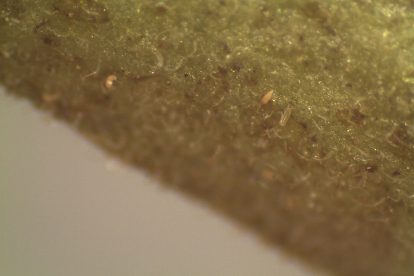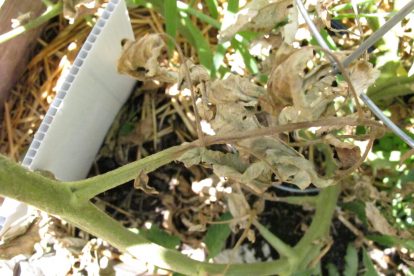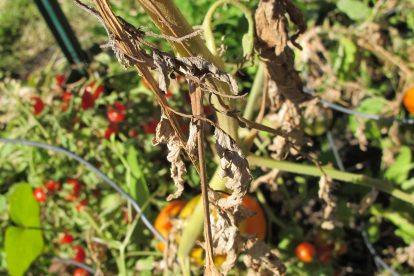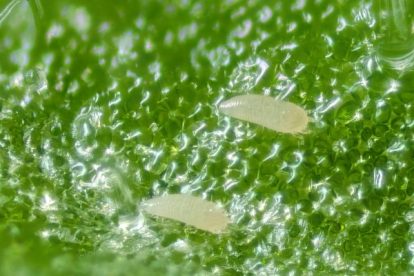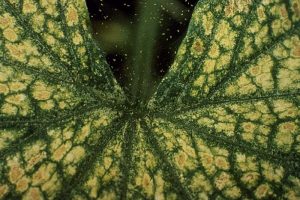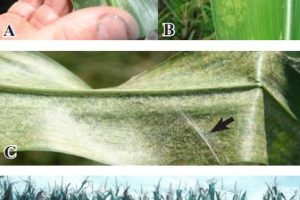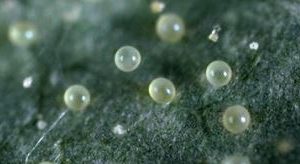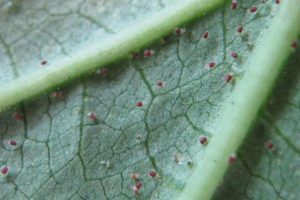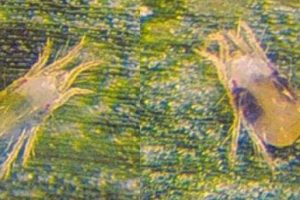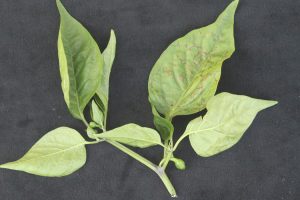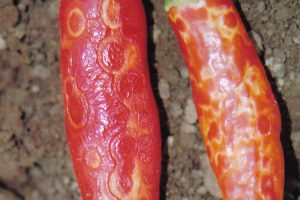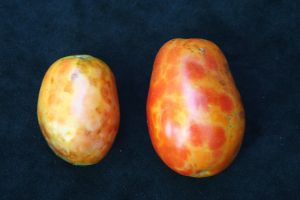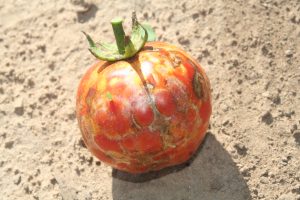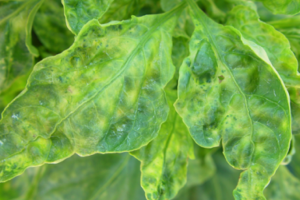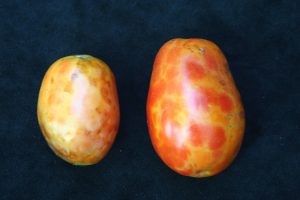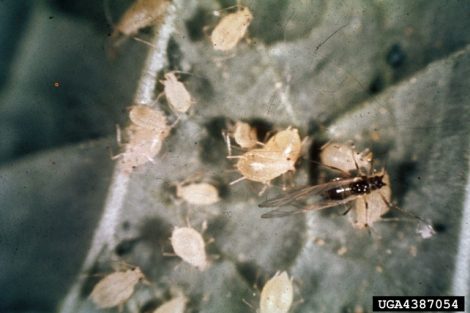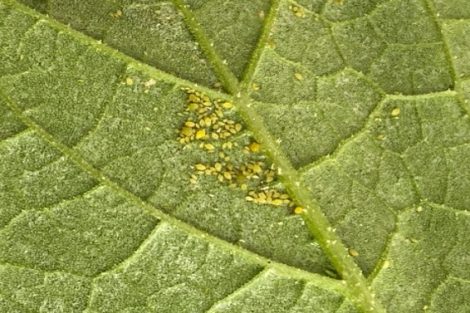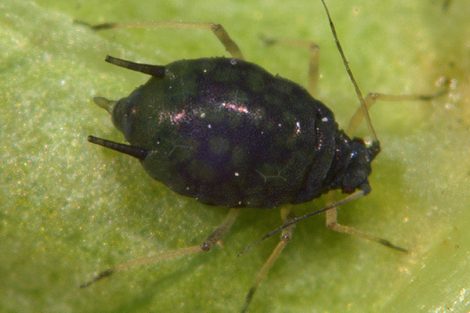Tomato Russet Mites
Occurrence: Active Now |
Description: They are most abundant during hot, dry weather in the mid-and late summer. They attack a variety of vegetables including tomato, eggplant, pepper, potato, and other solanaceous plants. The russet mite has a high reproductive potential (up to 53 eggs per female) and can complete a life cycle (egg to adult) in a week at warm temperatures. Females live for about 22 days laying eggs on the undersides of leaves, leaf petioles, and stems. Young nymphs tend to feed close to where they hatch. Mite feeding is usually concentrated on the lower part of the plant, but when infestations are severe and plants become heavily damaged, mites will disperse to upper leaves. Tomato russet mites can crawl between closely spaced plants that are touching and can be carried by the wind.
The presence of tomato russet mites often goes unnoticed due to their microscopic size until feeding injury is evident. Adults and nymphs insert their piercing-sucking mouthparts into plant tissue to imbibe plant juices. Injury from mite feeding can cause bronzing or “russeting” of the surface of stems, leaves, and fruits. Damaged leaves may turn yellow, curl, wither, and fall from plants. Mite feeding on fruits can cause longitudinal cracks and bronze coloration.
Management:
- Inspect transplants carefully to be sure they are free of russet mites.
- Avoid planting during hot, dry periods. Stressed seedlings are more vulnerable to attack by mites.
- Avoid transplanting seedlings near infested crops or weeds.
- Promptly remove or destroy infected plant debris.
- Sanitize equipment. Make sure any tools or equipment used on infested plants are properly cleaned before being used on healthy plants.
- Biological Control: There are several predatory mites that feed on tomato russet mites; however, there is often a lag time between the increase in populations of tomato russet and predatory mites.
- Insecticide Control: Once russet mites are present on plants; insecticide treatment is the primary control option. Apply the insecticide to the undersides of leaves where most mites are located.
Insecticide Options for Commercial Growers
| oxamyl | Vydate |
| pyrethrins | Pyganic |
| zeta-cypermethrin + avermectin B1 | Gladiator |
| bifenthrin + abamectin | Athena |
| abamectin | Agri-mek, Reaper |
| hexythiazox | Hexamite |
| chlorfenapyr | Pylon |
| spiromesifen | Oberon |
| spirotetramat | Kontos |
| Beauveria bassiana GHA | Botanigard |
| chromobacterium substsugae | Grandevo |
| metarhizium | Met52 |
| insecticidal soap | M-Pede |
| sodium tetraborohydrate decahydrate | Prev-AM |
| Burkolderia spp. | Venerate |
Insecticide Options for Home Gardeners
| pyrethrins + canola oil | Espoma insect Control, Monterey Take Down Garden Spray |
| pyrethrins + sulfur | Bonide Tomato and Vegetable 3 in 1, Natria Insect Disease & Mite Contorl, Ortho Insect Mite & Disease 3 in 1 |
| plant-based oils | Natural Guard Neem Spray, Monterey Neem Oil, Garden Safe Neem Oil, Monterey All Natural Mite & Insect Control |
| insecticidal Soap | Safer 3-in-1 Garden Spray, Natria Insecticidal Soap |
*Read product labels and ensure the product is listed to spray on the desired crop.
Reference: Utah Vegetable Production & Pest Management Guide, Tomato Russet Mite
Spider Mites
Occurrence: Active Now | Favor hot dry conditions
Description: Tomato russet mites (Aculops lycopersici) are microscopic (0.3 mm). Two common spider mite species include the Two-spotted Spider Mite (TSM) (Tetranychus urticae) and Bank’s Grass Mite (BGM) (Oligonychus pratensis). See images below. TSM and BGM have similar life cycles. The mites overwinter in non-crop and weedy areas such as grassy banks along irrigation ditches and roadsides, on weeds, in fallow fields, and in pastures. BGM can begin feeding on corn in the early to mid-summer and are more likely to remain on lower leaves. TSM populations increase in the mid-to-late summer, and they will spread onto entire corn plants. Mites can complete their development (one generation) in as quickly as one week; in cooler weather, it may take a month. Eggs hatch within 3 to 19 days depending on temperature. Webbing produced by spider mites helps fasten eggs to leaf surfaces and provides protective cover, making the eggs difficult to see. Unfertilized eggs develop into males and fertilized eggs develop into females.
Spider mites feed by piercing leaf cell walls with their mouthparts, sucking out the cell’s contents, and causing characteristic stippling damage (small spots). Heavily infested leaves are yellow or brown and may also appear burnt on the upper surface. Severe damage from mite feeding causes leaves to dry and fall off.
Management:
- Ensure adequate irrigation. Mites are more likely to develop economically damaging populations in fields that are moisture-stressed during the drier and hotter summer months. Frequent overhead irrigation or heavy rain can reduce the rate of mite population increase.
- Scout to detect mite infestations. Check the undersides of leaves for minute webbing on discolored leaves. Check plants that are on the field edges, especially in fields that are close to dusty roads, ditches, and grassy areas. Shake discolored leaves over a white piece of paper and look for dark specks that move. Use a hand lens or magnifying glass to see the tiny mites.
- Control weeds. Keep fields, field margins, and irrigation ditches clean of weeds. Spider mites use weeds as alternate food sources.
- Avoid creating heavy dust. Spider mite populations may increase rapidly in areas where dust deposits are heavy on corn leaves.
- Biological Control: The most important natural enemies of spider mites are a predatory mite, Amblyseius fallacis, minute pirate bug, Orius insidiosus, and Stethorus, a small black lady beetle known as the “spider mite destroyer.” Other predatory mites, thrips, and lacewing larvae prey on spider mites and offer some natural control.
Insecticide Options to Control Spider Mites on Sweet Corn for Commercial Growers (Review Labels for other Crops)
| phorate | Thimet |
| gamma-cyhalothrin | Declare |
| lambda-cyhalothrin | Warrior II |
| zeta-cyhalothrin + chlorantraniliprole | Besiege |
| pyrethrins + azadirachtin | Azera |
| abamectin | Agri-Mek |
| hexythiazox | Onager |
| propargite | Comite |
| spiromesifen | Oberon |
| Chromobacterium subtsugae | Grandevo |
Insecticide Options for Home Gardeners
| lambda-cyhalothrin | Spectracide Triazicide |
| pyrethrins + sulfur | Natria Insect, Disease, and Mite Control |
*Read product labels and ensure the product is listed to spray on the desired crop.
Reference: Utah Vegetable Production & Pest Management Guide, Spider Mites
Tomato Spotted Wilt Virus
Occurrence: Active Now |
Description: In Utah, Tomato spotted wilt virus (TSWV) most commonly affects tomatoes, peppers, and tomatillos. It is also found in ornamental plants such as blanket flowers (Gaillardia sp.), dahlias, and zinnia. TSWV has become more prevalent in Utah in recent years. Weeds can also serve as a host, notably pigweed, sow thistle, purslane, lambs quarter, and prickly lettuce. This virus is transmitted by western flower thrips (Frankliniella occidentalis) and onion thrips (Thrips tabaci), which are very small yellow/brown insects measuring less than 1 millimeter in size.
Symptoms of TSWV vary between plant species and within a species depending on the strain of the virus, time of infection, and plant variety. Infected plants are commonly stunted (generally more severe when young plants are infected). Leaves have necrotic spots, fruit may form necrotic rings, and seeds may become discolored (although TSWV is not seed transmitted). Mature fruit has calico patterns.
Management: This virus is occasional in Utah tomato production but is becoming more widespread. Once a plant is infected there is no cure, and if thrips are reproducing on the plant, it can serve as an inoculum source for neighboring plants. The virus is more likely to occur in fields that have had it in the past.
- Watch for symptoms throughout the growing season.
- Monitor thrips activity throughout the growing season.
- Monitor fields that had the virus in the past.
- Control thrips.
- Remove and destroy infected plants.
- Purchase healthy transplants.
- Use resistant varieties.
- Control weeds.
There are no chemical controls for TSWV
Reference: Fact Sheet, Tomato Spotted Wilt Virus of Tomato & Pepper
Reference: Vegetable Pests of Utah, Tomato Spotted Wilt Virus
Melon Aphids
Occurrence: Active Now | Carefully inspect the underside of cucurbit foliage
Description: Wingless females (1-2 mm long). Heads are green, but bodies vary from mottled light green, white, or yellow. Legs are pale with dark tips. The cornicles are also black. They overwinter as eggs on woody hosts and hatch in spring, producing only females. These spring aphids feed on the succulent new growth, and when mature, give birth asexually (parthenogenesis) to live female offspring. As the weather warms (70-81°F is optimal), aphids can complete a generation in as little as 7-8 days. Females can produce up to 12 nymphs per day for 50-100 total offspring. After 2-6 generations on the woody hosts, the aphids form wings and migrate to vegetable crops and other hosts for the summer, where they complete many more generations. As temperatures cool in the fall, aphids again form winged offspring (male and female) and return to winter host plants, where sexual mating occurs and eggs are laid for overwintering.
Management:
One of the most serious problems caused by aphids to vegetable crops is the spread of plant viruses. Viruses can dramatically reduce crop yield, and even kill plants. The green peach aphid can transmit common vegetable viruses like Alfalfa Mosaic Virus, Cucumber Mosaic Virus, Potato Virus Y, and Watermelon Mosaic Virus.
- Visually inspect plants for aphid colonies, feeding symptoms on growing tips, and curled leaves. Most aphid species prefer the undersides of leaves, so be sure to turn foliage over when scouting. Use a 10-20x hand lens for species identification.
- Look for small white flakes, which are the shedded skins of aphids.
- Yellow sticky traps are effective to monitor for the presence of winged aphids. Place traps 4–6 inches above susceptible host plants.
- Monitor plants for various symptoms of viruses. Vegetable viruses vectored by aphids include alfalfa mosaic virus, cucumber mosaic virus, potato virus Y, and watermelon mosaic virus.
- Look for a sticky substance called honeydew on leaves’ stems. It is a sugary, sticky secretion from aphids. It can cause the growth of a black sooty mold.
- Monitor for the presence of ants. Ants feed on excreted honeydew from aphids, which can indicate high populations.
- Use preventive measures. Before planting inside the high tunnel, remove weeds and volunteer crops that can serve as aphid hosts.
- Encourage natural enemies. Plant strips of yarrow, alyssum, herbs, and other plants with small, attractive flowers that provide nectar and pollen for beneficial insects.
- Inspect transplants. Before planting in your garden or field examine transplants for aphids.
- Manage nitrogen levels. High levels of nitrogen fertilizers tend to encourage aphid reproduction. Use several, staggered applications of lower concentrations of nitrogen rather than a single high dose. Also, use delayed-release formulations.
- Several natural predators feed on aphids. It is important to scout for these predatory and parasitic insects and eggs in and around your farm and garden. These natural predator populations can maintain aphids at low levels. However, predators will only show up if a food source exists, so there can be a lag time between the appearance of the aphids and the appearance of predators.
Insecticides should only be used when needed. Rotate among different insecticide classes between applications as aphids are prone to developing resistance. Resistance has occurred with pyrethroids for populations of green peach aphid and melon aphid in agriculturally intensive areas of the United States. Some insecticides may kill the beneficial insects mentioned above.
Effective home-use insecticides registered for aphid control in Utah.
| Active Ingredient | Products |
| malathion | Spectracide Malathion, Ortho Malathion |
| cyfluthrin | BioAdvanced Vegetable and Garden Insect Spray |
| gamma-cyhalothrin | Spectracide Triazicide |
| permethrin | Bonide Eight Vegetable, Fruit & Flower |
| pyrethrins | Monterey Bug Buster-O, Worry-Free Insecticide |
| zeta-cypermethrin | GardenTech Sevin |
| pyrethrins + insecticidal Soap | Safer Brand Tomato & Vegetable Insect Killer |
| spinosad | Monterey Garden Insect, Bonide Captain Jack’s Deadbug, Natural Guard Spinosad Spray |
| oils: plant-based | Natural Guard Neem Spray, Monterey Neem Oil, Garden Safe Neem Oil |
| oils: mineral oil | Bonide All Season Spray Oil, Monterey Horticultural Oil |
| potassium salts of fatty acids (insecticidal soap) | Safer 3-in-1 Garden Spray, Natria Insecticidal Soap |
Reference: Fact Sheet, Aphid Pests of Vegetables

